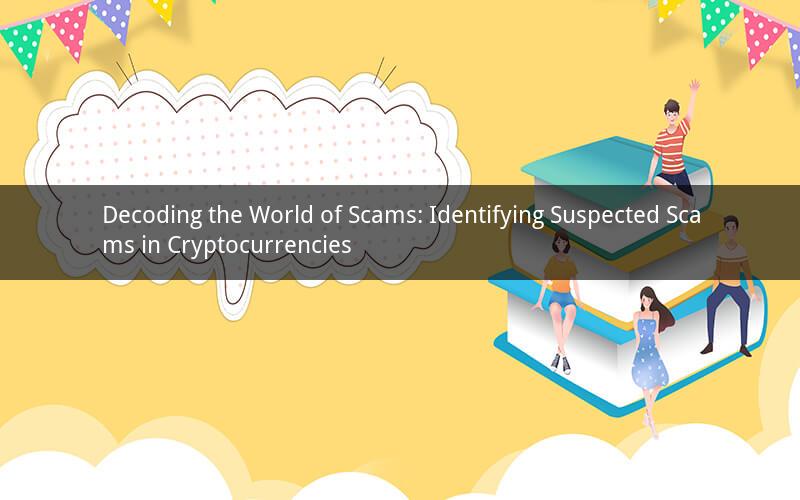
In the rapidly evolving landscape of cryptocurrencies, it's crucial to discern between legitimate projects and potential scams. This article delves into the realm of cryptocurrency scams, highlighting the red flags that indicate a particular cryptocurrency might be fraudulent. By understanding these warning signs, investors can protect themselves from falling prey to these deceptive schemes.
1. Lack of Transparency
One of the most prominent indicators of a suspected cryptocurrency scam is a lack of transparency. Legitimate projects typically provide comprehensive information about their team, technology, and business model. However, scam projects often fail to provide this crucial information, leaving investors in the dark.
2. Unusually High Returns
Scammers often promise unrealistic returns on investment, luring unsuspecting individuals with the allure of quick wealth. These excessive returns are often too good to be true and should serve as a red flag. Legitimate cryptocurrency projects focus on sustainable growth and long-term value, not instant riches.
3. Poor Security Measures
Security is a cornerstone of any reputable cryptocurrency project. If a project lacks robust security measures, it raises concerns about its legitimacy. Scammers often exploit vulnerabilities to steal funds, making it essential to scrutinize a project's security protocols before investing.
4. Unregulated Exchanges
Scammers frequently use unregulated exchanges to facilitate their fraudulent activities. These exchanges often lack the necessary safeguards to protect investors' funds, making it easier for scammers to manipulate prices and steal assets. Avoiding unregulated exchanges is crucial in identifying suspected scams.
5. Pump and Dump Schemes
Pump and dump schemes are a common scam in the cryptocurrency world. Scammers artificially inflate the price of a cryptocurrency, then sell their holdings, leaving unsuspecting investors with substantial losses. Identifying unusual price volatility and sudden spikes can help detect these fraudulent activities.
6. Phishing Attacks
Phishing attacks are another prevalent method used by scammers to deceive investors. These attacks involve sending fraudulent emails or messages that appear to be from reputable sources, tricking individuals into providing their personal information or making unauthorized transactions. Being vigilant against phishing attempts is essential in avoiding scams.
7. False Endorsements
Scammers often use false endorsements from well-known figures or reputable organizations to lend credibility to their fraudulent projects. These endorsements are typically fake and should be treated with skepticism. Conduct thorough research to verify the authenticity of any endorsements before investing.
8. Unnecessary Complexity
Legitimate cryptocurrency projects strive to create simple and user-friendly platforms. Scammers, on the other hand, often create overly complex projects that are difficult to understand. This complexity is used as a means to confuse investors and obscure the true intentions of the project.
9. Absence of a Whitepaper
A whitepaper is a detailed document that outlines the technology, goals, and business model of a cryptocurrency project. Scammers often fail to provide a whitepaper, making it difficult for investors to understand the project's purpose and potential risks. A lack of a whitepaper should be treated as a significant red flag.
10. Unethical Marketing Practices
Scammers frequently employ unethical marketing practices to lure investors. These practices may include making false claims, exaggerating the potential returns, or using fear tactics to pressure individuals into making quick decisions. Being wary of these tactics can help identify potential scams.
Frequently Asked Questions:
Q1: How can I differentiate between a legitimate cryptocurrency and a suspected scam?
A1: Conduct thorough research on the project, including its team, technology, security measures, and reputation. Pay attention to transparency, regulatory compliance, and ethical marketing practices.
Q2: What should I do if I suspect a cryptocurrency project is a scam?
A2: Avoid investing in the project and report it to the appropriate authorities. Share your concerns with the cryptocurrency community to help others avoid falling victim to the scam.
Q3: How can I protect myself from phishing attacks in the cryptocurrency world?
A3: Be cautious of unsolicited emails or messages, never share your personal information, and always verify the authenticity of any communication before taking action.
Q4: Are there any regulatory bodies that can help identify suspected cryptocurrency scams?
A4: Yes, regulatory bodies such as the Securities and Exchange Commission (SEC) and the Financial Conduct Authority (FCA) can provide guidance and assistance in identifying and reporting scams.
Q5: How can I stay informed about the latest cryptocurrency scams?
A5: Follow reputable news sources, join cryptocurrency forums, and participate in online communities. Staying informed and vigilant is the best way to protect yourself from falling victim to scams.